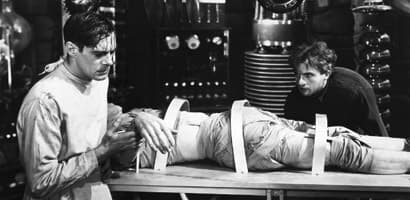Frankenstein (James Whale, 1931): United States
Reviewed by Kristy Cooper. Viewed at home, rented from the Stanislaus County Library

Frankenstein, directed by James Whale and produced by the famous Carl Laemmle for Universal Pictures in 1931, is a film about not the monster, which most people might think, but is a story of a scientist’s dream to recreate life. Colin Clive plays the man responsible for putting God’s hands into his own and is named Dr. Henry Frankenstein. This isn’t the first time a director has tried their hands at making a horror genre film; the adaption of Mary Shelley’s novel Frankenstein was first attempted in 1910 by Thomas Edison’s studio. But this film furthers Mary Shelley’s character and tackles the psychosis of Dr. Frankenstein with much more depth. Dr. Frankenstein envisions himself as a genius for creating the inevitable. The experiment entails taking parts from other dead bodies that are “resting and waiting for a new life”, as he creepishly points out in the beginning of the film after digging up a freshly buried body out of its grave. The film opens up with nothing I have ever seen before; a commentary spoken by an unnamed man provoking fear into the audience and warning them of the potential fright that comes along with watching. This opening puts the audience into a theater like you are about to watch a live play. The credits then show, and reveals the cast’s names along with their character’s names. The monster is defined by a question mark, because, who really does play the monster when it is constructed of more than one person? The answer is actor Boris Karloff who is the 1930s man that captivates audiences in the horror films such as Frankenstein, The Bride of Frankenstein, The Mummy, and The Old Dark House.
The plot of the story begins about nine minutes in after the introduction. Frankenstein’s humpback-sidekick Fritz, portrayed by Dwight Frye, is shown stealing a brain at the University where Dr. Frankenstein was studying. After being scared by a loud noise, Fritz accidently drops the brain labeled normal, and instead grabs the other brain labeled abnormal and dysfunctional. He then runs off to give the brain to Dr. Frankenstein. We can only infer from this scene that this must mean danger for the ensuing events that are about to take place.
The next scene reveals that Dr. Frankenstein is a fiancée to a beautiful woman named Elizabeth, played by Mae Clark, who surprises me throughout the film with her nurturing demeanor towards her future husband. She paces with worry and calls upon the help of Frankenstein’s best friend Victor Moritz. She has received a letter confessing the secret experiments that are going on in a place unknown to her. She is shown worried and stressed, all while being completely mindful and respectful of her fiancée’s sanity. These two characters move the plot along with their adventure to save the mind of their beloved Henry Frankenstein.
Along with the mise-en-scene of lonely, dark, and rainy nights, Whale brings out the horror in his film with the dialogue the most. Throughout the film, his characters use words like sanity, doubt, crazy, dangerous, brutality, violence, murder, while speaking of heaven, hell, eternity, and evil. This film is dark and eerily constructed. One specific term that is repeated over is brain. Dr. Frankenstein uses this word and says, “We must find a new brain,” as if he was speaking to himself about the mad sanity that has taken over his own. Through the film, he seems to calm down and come back to reality with the help Elizabeth, Victor, and his previous professor. But the realization that his monster is still lurking in public, brings him back to his obsession. Also, the famous quote in film history, “It’s Alive!” comes from Frankenstein after he miraculously succeeds in his experiment with the monster.
Furthermore, the scientist only sees his monster as a toy for analyzing and investigating behaviors. Although the monster commits murder and terrorizes people, he only does this through ignorance. His brain is confused and fogged. He doesn’t know any better and makes you feel for his situation. The scene with Fritz whipping the monster and flashing fire in his face makes you question whether the monster is the monster, or are the characters the monster for putting an innocent “thing” in its situation. In comparison, the film Carrie (Kimberly Pierce, 2013) shares the same thematic element of a character being misunderstood by the people around him or her. Carrie is harshly criticized by her peers for being “different” and does not understand why. She then opens up her rage at the end and kills those same peers. But she still shows compassion when saving the one person that was nice to her. Same with the monster: he opens up and shows compassion to the little girl after escaping from his dungeon. The little girl was the only one who did not treat him differently.
Without spoiling the entire film, I must say that this is one of the best horror films I have seen and encourage more people to watch. It has a way of frightening without the gore and blood we see too often with current films. This film shows its art through a spectrum which is implied psychologically and mentally and reveals the dark side of science.
About this entry
You’re currently reading “Frankenstein (James Whale, 1931): United States,” an entry on Student Film Reviews
- Published:
- 11.16.14 / 8am
- Category:
- Films
12 Comments
Jump to comment form | comments rss [?] | trackback uri [?]